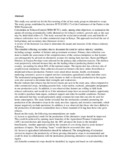| dc.description.abstract | This study was carried out for the first meeting of the ad hoc study group on alternatives crops. The study
group, established by decision FCTC/COP1(17) of the Conference of the Parties to the WHO Framework
Convention on Tobacco Control (WHO FCTC), seeks, among other objectives, to summarize the uptake of
existing economically viable alternatives for tobacco workers, growers and, as the case may be, individual
sellers (1). The study assessed the social and economic costs and benefits of tobacco cultivation vis-à-vis
other commercial crops in Kenya. The approach involved the use of both primary and secondary data
(literature review).
A review of the literature was done to determine the nature and structure of the tobacco industry in Kenya.
This entailed collecting secondary data to document the trend in various industry variables, including
acreage, number of farmers and government revenues. Primary data collection was done to enable the
assessment of the competitiveness of the various enterprises so that farmers can subsequently be advised on
alternative avenues for raising farm incomes. Kuria and Migori Districts in Nyanza Province were selected
for the primary data collection exercise. The districts were purposively selected because they are the leading
tobacco producing districts in the country, accounting for about 80% of the national output. The region also
has a diverse mix of crop/livestock enterprises. Data collection focused on farmers who have either
diversified or abandoned tobacco production. Farmers were asked about income, health, environment,
marketing structures, access to support services (extension, agricultural credit) and other costs. The
institutional arrangements that assist farmers to shift or diversify production in the region were also assessed
to determine their strengths and weaknesses.
Results indicate that tobacco has the lowest returns per acre in the study area, when compared to other
commercial crops, including passion fruit, water-melon, soybeans, pineapples and peppers in one production
cycle. In addition, it was observed that farmers are willing to shift from tobacco cultivation, and would do so
if the introduced crops have an assured market, opportunity for credit to purchase farm inputs, technical
support and other favourable conditions. Farmers also indicated that they would particularly adopt
commercial crops that can also be used for home consumption. The study further revealed that the
institutions currently promoting the production of the alternative crops in the study area face capacity and
resource constraints, which impact negatively on their operations. In addition, it was observed that those who
have shifted to the production of alternative commodities have a better standard of living than those who
grow tobacco.
Based on this study, the following recommendations are made:
(i) Access to agricultural credit for the production of the alternative crops should be improved. This could be
achieved by opening more branches of the Agricultural Finance Corporation (AFC) in rural districts and
ensuring that the AFC advances the loans to the intended beneficiaries. Another approach would be the
creation of a revolving fund to assist farmers’ purchases of inputs. The resulting “loans” would then be
recovered after sales.
(ii) Access to agricultural information should be enhanced. The strengthening of extension services to
improve the productivity of those growing alternative crops is recommended and could be done in
collaboration with the institutions promoting alternative crop production in the region.
(iii) Suitable commercial crops should be identified, by region and based on soil suitability.
iv
(iv) A sensitization program for farmers should be undertaken, in order to make them aware of the problems
associated with tobacco farming and to assist them in shifting to the production of alternative crops with
higher returns.
(v) Environmentally sound measures to control pests and diseases should be implemented and used
effectively. This may entail the promotion of organic farming to produce the identified commodities, which
will further increase farm incomes due to the premiums attached to organic products, especially in the export
markets.
(vi) Existing agricultural institutions should be strengthened to effectively carry out their duties. The study
suggests the establishment of additional commodity-based cooperatives to aid farmers in agricultural
production and marketing. It further recommends training for institutional personnel and financial assistance
(grants or soft loans) to facilitate operations. These institutions could also manage the revolving fund,
identify markets for farmers and purchase inputs for farmers at a discount.
(vii) Agricultural institutions should foster effective linkages with government institutions, including the
national extension institution, Kenya Agricultural Research Institute (KARI), among others. The
development of such partnerships will not only enhance access to agricultural information, but may also
ensure that farmers benefit from improved seed varieties and other services. | en_US |


